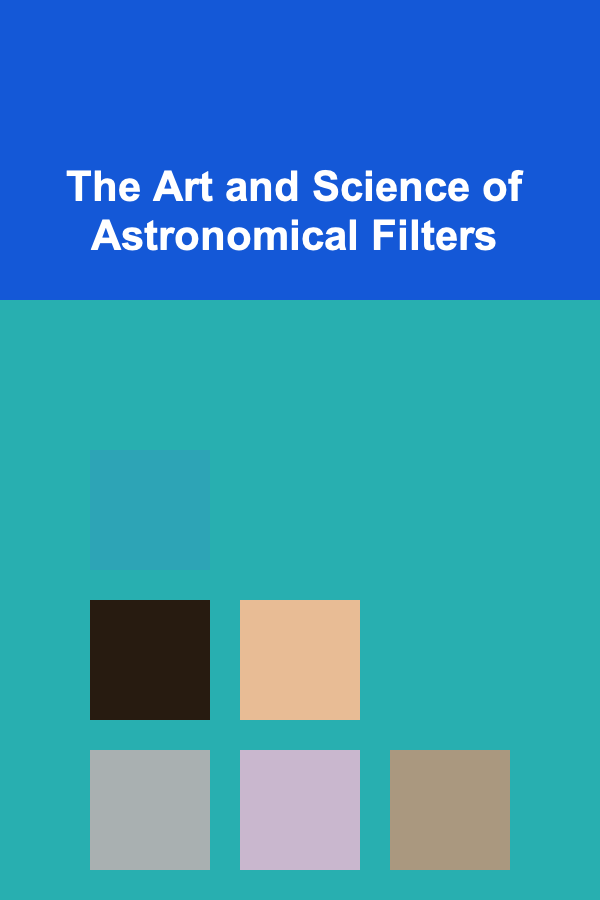
The Art and Science of Astronomical Filters
ebook include PDF & Audio bundle (Micro Guide)
$12.99$10.99
Limited Time Offer! Order within the next:

Astronomical filters are indispensable tools for both visual observers and astrophotographers. They selectively block or transmit specific wavelengths of light, enhancing contrast, revealing subtle details, and mitigating the effects of light pollution. Understanding the different types of filters, their characteristics, and how to use them effectively can significantly improve your observing experience and the quality of your astronomical images. This comprehensive guide delves into the world of astronomical filters, covering everything from basic principles to advanced techniques.
Understanding the Basics of Light and Filters
To effectively use astronomical filters, it's crucial to understand the fundamental properties of light and how filters interact with it. Light, in the context of astronomy, is electromagnetic radiation spanning a wide spectrum, from radio waves to gamma rays. However, the visible spectrum -- the portion of the electromagnetic spectrum that our eyes can detect -- is particularly relevant for visual observation and most astrophotography. This spectrum ranges from approximately 400 nanometers (nm) at the violet end to 700 nm at the red end. Filters work by selectively transmitting or blocking different wavelengths within this spectrum (and sometimes beyond).
Filters are typically characterized by several key properties:
- Transmission Curve: This graph shows the percentage of light transmitted by the filter at each wavelength. It's the most critical specification, as it defines the filter's behavior. Look for curves that are relatively flat and high within the passband and steeply declining outside of it.
- Bandwidth: This refers to the width of the wavelength range that the filter transmits. Narrowband filters have a small bandwidth (e.g., 3nm, 7nm), while broadband filters have a wide bandwidth (e.g., hundreds of nanometers).
- Peak Transmission: This is the wavelength at which the filter transmits the most light.
- Blocking: This refers to how well the filter blocks unwanted light outside of its passband. A good filter should have high blocking in regions where light pollution is prevalent (e.g., mercury and sodium emission lines).
- Substrate Quality: The quality of the glass or other material used to make the filter is important for image sharpness and minimizing distortion. Look for filters made from high-quality, optically flat substrates.
Different filter types achieve their selective transmission and blocking using various physical mechanisms, including interference coatings, absorption dyes, and a combination of both.
Types of Astronomical Filters
The world of astronomical filters is vast, encompassing a wide variety of types designed for specific purposes. Here's a breakdown of the most common categories:
Light Pollution Filters
Light pollution filters are designed to mitigate the effects of artificial light sources on astronomical observations. They work by blocking specific wavelengths emitted by common types of streetlights, such as mercury-vapor and sodium-vapor lamps, while allowing other wavelengths to pass through. These filters generally fall into two categories:
- Broadband Light Pollution Filters (LPF): These filters block a wider range of wavelengths associated with light pollution. They are a good general-purpose choice for urban observers and can significantly improve the visibility of many deep-sky objects, especially nebulae. Examples include the Orion UltraBlock, the SkyGlow filter, and similar "light pollution reduction" filters. These filters are generally better suited for visual observing than narrowband filters when dealing with moderate light pollution.
- Narrowband Light Pollution Filters (e.g., UHC/OIII): These filters have a much narrower bandwidth and are designed to transmit only the wavelengths of light emitted by ionized oxygen (OIII) and hydrogen-beta (Hβ) -- two prominent emission lines in many nebulae. UHC filters typically transmit both OIII and Hβ, while OIII filters only transmit OIII. These filters can dramatically improve the visibility of emission nebulae and planetary nebulae, even under relatively heavy light pollution. They are particularly effective on objects like the Orion Nebula, the Lagoon Nebula, and the Veil Nebula.
It's important to note that light pollution filters are not a substitute for a dark sky. They selectively block certain wavelengths but don't eliminate the overall glow of light pollution. Also, broadband light pollution filters can slightly alter the color balance of celestial objects, although this is often a worthwhile tradeoff for the increased contrast.
A visual comparison of the effect of different light pollution filters on observing nebulae.
Color Filters for Planetary Observation
Color filters are invaluable tools for enhancing detail on planets. Each filter transmits a specific range of wavelengths, highlighting features that are more prominent at those wavelengths. Here's a summary of commonly used color filters and their applications:
- Red (e.g., Wratten #25, #29): Enhances contrast in Martian surface features, darkens blue clouds in Jupiter and Saturn, and reveals details in the polar regions of these planets.
- Orange (e.g., Wratten #21): Similar to red filters but with a slightly less intense effect. Useful for observing Martian dust storms and enhancing contrast on Jupiter and Saturn.
- Yellow (e.g., Wratten #12, #15): Improves contrast of lunar and Martian features, enhances cloud details on Jupiter and Saturn, and darkens blue regions in planetary atmospheres.
- Green (e.g., Wratten #56, #58): Enhances contrast of Martian polar caps and brightens yellowish dust clouds. Improves visibility of dark belts and red spots on Jupiter. Increases contrast of Saturn's rings and belts.
- Blue (e.g., Wratten #80A, #38A): Enhances detail in Jupiter's cloud belts, reveals atmospheric features on Mars, and shows cloud patterns on Venus. Also useful for splitting close double stars.
- Violet (e.g., Wratten #47): Primarily used for observing Venus. Helps to reveal subtle cloud features in ultraviolet light.
Experimentation is key when using color filters for planetary observation. The best filter to use will depend on the specific planet, the observing conditions, and your personal preference. Generally, it's a good idea to start with a light-colored filter and gradually increase the intensity until you find the one that provides the best contrast and detail.
Solar Filters
Safety is paramount when observing the Sun. Never look directly at the Sun through a telescope or binoculars without a proper solar filter, as this can cause permanent eye damage, including blindness. Solar filters are designed to block the vast majority of the Sun's light and heat, allowing you to safely observe solar features such as sunspots, prominences, and flares.
There are two main types of solar filters:
- White Light Filters: These filters block all but a tiny fraction of the Sun's light across the visible spectrum. They allow you to observe sunspots and granulation (the mottled appearance of the Sun's photosphere). White light filters come in two main varieties: glass filters and mylar film filters. Glass filters tend to be more expensive but offer higher image quality. Mylar film filters are more affordable but can sometimes introduce slight distortions.
- Hydrogen-Alpha (Hα) Filters: These filters transmit only a very narrow band of light centered on the hydrogen-alpha emission line at 656.3 nm. This allows you to observe prominences (eruptions of hot gas extending from the Sun's surface) and filaments (dark, thread-like features on the Sun's disk). Hα filters are significantly more expensive than white light filters but offer a much more dynamic and detailed view of the Sun. Always use a dedicated Hα telescope or filter system designed for solar observation. Do not attempt to use a narrowband Hα filter intended for deep-sky imaging on the Sun without proper and safe solar blocking filters in place.
Always inspect your solar filter for any signs of damage before each use. Even a small pinhole can allow enough sunlight to pass through to cause eye damage. Follow the manufacturer's instructions carefully when installing and using your solar filter.
Narrowband Filters for Deep-Sky Imaging
Narrowband filters are essential tools for astrophotography, particularly when imaging under light-polluted skies. They isolate specific emission lines from ionized gases in nebulae, allowing you to capture stunning images even from urban locations. The most common narrowband filters are:
- Hydrogen-Alpha (Hα): Transmits light emitted by hydrogen atoms, revealing the structure of emission nebulae like the North America Nebula and the Rosette Nebula.
- Oxygen-III (OIII): Transmits light emitted by doubly ionized oxygen, highlighting regions of high excitation in planetary nebulae and supernova remnants like the Veil Nebula.
- Sulfur-II (SII): Transmits light emitted by ionized sulfur, often revealing different structures than Hα and OIII, and adding depth to narrowband images.
By combining images taken through Hα, OIII, and SII filters, astrophotographers can create stunning "Hubble Palette" images, which are often rendered in false color to highlight the different chemical compositions and physical processes within nebulae. Narrowband filters are also used to create monochrome images with extremely high contrast, revealing faint details that would otherwise be lost in the background skyglow. Typical bandwidths for narrowband filters range from 3nm to 12nm.
Infrared (IR) Cut Filters
While not strictly a "filter" in the same sense as the others, an IR cut filter is often crucial for digital astrophotography. Many digital cameras, especially DSLRs and mirrorless cameras, are sensitive to infrared (IR) light, which lies beyond the red end of the visible spectrum. IR light can degrade image sharpness, introduce unwanted color casts, and reduce contrast. An IR cut filter blocks IR light, resulting in sharper, cleaner images. Most modern cameras have a built-in IR cut filter, but some dedicated astronomy cameras may omit it for increased sensitivity, requiring an external IR cut filter to be used with them.
UV/IR Cut Filters
These filters are designed to block both ultraviolet (UV) and infrared (IR) light. While some dedicated astronomy cameras might benefit from UV sensitivity in certain situations, for most visual observing and general astrophotography, these wavelengths just contribute to image degradation. These filters are a good all-around choice, especially when using refractors, which can suffer from chromatic aberration (color fringing) due to UV and IR light focusing at different points than visible light.
Choosing the Right Filter
Selecting the appropriate filter depends on several factors, including:
- Observing Goal: What are you trying to observe? Planets require different filters than nebulae, and solar observing requires specialized safety filters.
- Sky Conditions: How much light pollution are you dealing with? Heavier light pollution requires narrower bandwidth filters.
- Telescope Aperture: Larger telescopes gather more light and can benefit from narrower bandwidth filters.
- Camera Type (for Astrophotography): Different cameras have different sensitivities to various wavelengths of light, which will affect filter choice.
- Budget: Filters range in price from relatively inexpensive to very expensive. Start with a few essential filters and gradually expand your collection as needed.
Here are some general recommendations:
- Urban Visual Observing: Start with a broadband light pollution filter (LPF) or a UHC filter for observing nebulae. Add color filters for planetary observation.
- Dark Sky Visual Observing: Color filters for planetary observation are essential. Consider an OIII filter for enhancing certain nebulae. Light pollution filters are less critical but can still improve contrast on some objects.
- Light-Polluted Astrophotography: Narrowband filters (Hα, OIII, SII) are a must for imaging nebulae. An LPF can be helpful for broadband imaging. An IR cut filter is often necessary.
- Dark Sky Astrophotography: Broadband filters (RGB or LRGB) are ideal for capturing natural-color images of galaxies and star clusters. Narrowband filters can be used to enhance emission nebulae. An IR cut filter is generally recommended.
Read reviews and compare specifications before purchasing filters. Talk to other astronomers and get their recommendations. A well-chosen set of filters can dramatically improve your astronomical observing and imaging capabilities.
Using Filters Effectively: Tips and Techniques
Once you have a selection of filters, it's important to use them effectively to maximize their benefits. Here are some tips and techniques:
Visual Observing
- Start with Low Power: Use a low-power eyepiece to locate your target object before inserting a filter.
- Experiment with Different Filters: Try different filters to see which one provides the best contrast and detail for the specific object you are observing.
- Adapt Your Eyes: Allow your eyes to adapt to the darkness for several minutes after inserting a filter. This will maximize your sensitivity to faint details.
- Use Averted Vision: Look slightly to the side of your target object to improve your ability to see faint details.
- Observe Under Steady Skies: Filters can enhance details, but they can't compensate for poor seeing conditions (atmospheric turbulence).
- Consider Filter Wheels/Sliders: For convenient filter changes, especially with multiple filters, consider using a filter wheel or slider.
Astrophotography
- Accurate Focusing: Precise focusing is crucial for capturing sharp images. Use a Bahtinov mask or similar focusing aid.
- Longer Exposures: Narrowband filters block a significant amount of light, so longer exposures are typically required.
- Proper Guiding: Accurate guiding is essential for long exposures.
- Calibration Frames: Use dark frames, flat frames, and bias frames to calibrate your images and remove artifacts.
- Image Processing: Image processing is a critical step in astrophotography. Use software like PixInsight, Astro Pixel Processor, or Photoshop to stack, align, and enhance your images. When using narrowband filters, consider using a color mapping technique (e.g., the Hubble Palette) to highlight the different emission lines.
- Filter Order: Place the filter as close to the camera sensor as possible to minimize reflections and vignetting.
Stacking Filters
In some cases, it may be advantageous to stack filters. For example, you might combine a broadband light pollution filter with a UHC or OIII filter for even greater light pollution reduction. Or you might stack color filters to achieve a specific effect. However, be aware that stacking filters can also reduce the overall amount of light reaching the camera or eye, so it's important to experiment and determine what works best for your particular setup and observing conditions.
Filter Care and Maintenance
Proper care and maintenance are essential for ensuring the longevity and performance of your filters. Here are some tips:
- Handle with Care: Avoid touching the filter surfaces with your fingers. Use lens tissue or a microfiber cloth to clean them.
- Store Properly: Store your filters in a clean, dry, and dust-free environment, such as a filter case or box.
- Clean Regularly: Clean your filters regularly to remove dust, fingerprints, and other contaminants. Use a lens cleaning solution and a microfiber cloth. Gently wipe the filter surfaces in a circular motion.
- Avoid Harsh Chemicals: Do not use harsh chemicals or abrasive cleaners on your filters.
- Inspect Regularly: Inspect your filters regularly for any signs of damage, such as scratches, cracks, or delamination of the coatings. Replace damaged filters as needed.
Advanced Techniques: Multi-Band Imaging and Custom Filters
Beyond the standard filter sets, advanced astrophotographers often explore multi-band imaging techniques and even custom-designed filters to achieve specific results.
Multi-Band Imaging
Multi-band imaging involves combining images taken through multiple filters to create more detailed and informative images. This can involve combining narrowband filters (Hα, OIII, SII) to create Hubble Palette images, or combining broadband filters (RGB or LRGB) with narrowband filters to enhance specific features. For example, you might add Hα data to a broadband RGB image of a galaxy to highlight the emission nebulae within the galaxy's spiral arms.
Custom Filters
For very specific applications, some astrophotographers opt for custom-designed filters. These filters can be tailored to transmit or block specific wavelengths of light that are not covered by standard filters. Custom filters are often used for scientific research or for creating unique and artistic images.
Bi-Color Imaging
Bi-color imaging involves combining only two narrowband filters, typically Hα and OIII, to create an image. This technique is often used when light pollution is particularly severe, or when the target object is primarily emitting in these two wavelengths. The images are then mapped to red and green/blue channels respectively, often resulting in a visually striking image with good detail.
Conclusion
Astronomical filters are powerful tools that can significantly enhance your observing and imaging capabilities. By understanding the different types of filters, their characteristics, and how to use them effectively, you can unlock a new level of detail and beauty in the night sky. Experiment with different filters and techniques to discover what works best for your particular setup and observing conditions. Remember to always prioritize safety when observing the Sun and to properly care for your filters to ensure their longevity and performance. Happy observing!

How To Cultivate a Growth Mindset in Your Career
Read More
How to Use Technology to Improve Your Logistics Operations
Read More
Understanding the Art of Storytelling Through Design
Read More
Mastering Time Management for Freelancers: A Comprehensive Guide
Read More
How To Lead Productive Meetings
Read More
How to Store Fresh Produce to Make It Last
Read MoreOther Products

How To Cultivate a Growth Mindset in Your Career
Read More
How to Use Technology to Improve Your Logistics Operations
Read More
Understanding the Art of Storytelling Through Design
Read More
Mastering Time Management for Freelancers: A Comprehensive Guide
Read More
How To Lead Productive Meetings
Read More